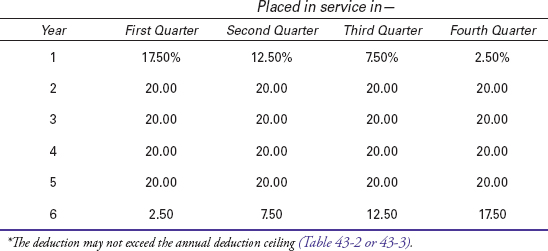43.3 Depreciation Restrictions on Cars, Trucks, and Vans
The law contains restrictions on so-called “listed property” that limit and, in some cases, deny depreciation deductions for a business car, truck, or van. Employees may be unable to claim any deduction at all under an employer convenience test. Employees meeting that test and self-employed individuals must determine if they can use accelerated MACRS rates or must use straight-line rates. Finally, regardless of which depreciation method is used, the annual deduction may not exceed a ceiling set by law for passenger cars and certain light trucks and vans; details on the annual ceilings are in the following section (43.4).
Employee must satisfy employer convenience test.
If you are an employee and use your own vehicle for work, you must be ready to prove that you use it for the convenience of your employer who requires you to use it in your job. If you do not meet this employer convenience test, you may not claim depreciation or first-year expensing. A letter from your employer stating you need the vehicle for business will not meet this test.
The facts and circumstances of your use of the vehicle may show that it is a condition of employment. For example, an inspector for a construction company uses his automobile to visit construction sites over a scattered area. The company reimburses him for his expenses. According to the IRS, the inspector’s use of the car is for the convenience of the company and is a condition of the job. However, if a company car were available to the inspector, the use of his own car would not meet the condition of employment and convenience of the employer tests.
More-than-50%-business-use test for claiming expensing or accelerated MACRS depreciation.
Automobiles and other vehicles used to transport persons or goods are considered “listed property” (42.10), whether you are an employee or are self-employed, but there are exceptions for ambulances, hearses, and trucks or vans that are qualified non-personal-use vehicles (43.4). Unless the vehicle is excepted from the listed property rules, you may claim bonus depreciation, first-year expensing or accelerated MACRS (43.5) for a vehicle placed in service during 2012 only if you use it in 2012 more than 50% of the time for business. The annual ceiling, if applicable (43.4), applies to the total of any bonus allowance, first-year expensing and MACRS depreciation.
If business use is 50% or less in the year the vehicle is placed in service, bonus depreciation, first-year expensing and accelerated MACRS are barred; depreciation must be claimed over a six-year period under the straight-line method. Technically, the recovery period is five years but the period is extended to six years because, in the first year, a convention rule limits the deductible percentage. See Tables 43-6 and 43-7 (43.6). The straight-line method must also be used in future years, even if business use in those years exceeds 50%.
Table 43-6 Straight-Line Half-Year Convention*
| Straight-line year— | Half-year convention rate— |
| 1 | 10% |
| 2 | 20 |
| 3 | 20 |
| 4 | 20 |
| 5 | 20 |
| 6 | 10 |
* The deduction may not exceed the annual deduction ceiling (Table 43-2 or 43-3).
Table 43-7 Straight-Line Mid-Quarter Convention*

If a vehicle is used for both business and investment purposes, only business use is considered in determining whether you meet the more-than-50%-business-use test and therefore qualify for MACRS. However, investment use is added to business use in determining your actual deduction.
Do your employees use the vehicle?
In certain cases, an employer who provides a vehicle to employees as part of their compensation may be unable to count the employee’s use as qualified business use, thereby preventing the employer from meeting the more-than-50%-business-use test for claiming MACRS. An employer is allowed to treat the employee’s use as qualified business use only if: (1) the employee is not a relative and does not own more than 5% of the business and (2) the employer treats the fair market value of the employee’s personal use of the vehicle as wage income and withholds tax on that amount. If such income is reported, all of the employee’s use, including personal use, may be counted by an employer as qualified business use.
If an employee owning more than a 5% interest is allowed use of a company-owned vehicle as part of his or her compensation, the employer may not count that use as qualified business use, even if the personal use is reported as income. The same strict rule applies if the vehicle is provided to a person who is related to the employer.
